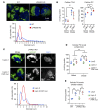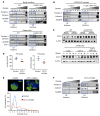Lipin 2/3 phosphatidic acid phosphatases maintain phospholipid homeostasis to regulate chylomicron synthesis
- PMID: 30507612
- PMCID: PMC6307960
- DOI: 10.1172/JCI122595
Lipin 2/3 phosphatidic acid phosphatases maintain phospholipid homeostasis to regulate chylomicron synthesis
Abstract
The lipin phosphatidic acid phosphatase (PAP) enzymes are required for triacylglycerol (TAG) synthesis from glycerol 3-phosphate in most mammalian tissues. The 3 lipin proteins (lipin 1, lipin 2, and lipin 3) each have PAP activity, but have distinct tissue distributions, with lipin 1 being the predominant PAP enzyme in many metabolic tissues. One exception is the small intestine, which is unique in expressing exclusively lipin 2 and lipin 3. TAG synthesis in small intestinal enterocytes utilizes 2-monoacylglycerol and does not require the PAP reaction, making the role of lipin proteins in enterocytes unclear. Enterocyte TAGs are stored transiently as cytosolic lipid droplets or incorporated into lipoproteins (chylomicrons) for secretion. We determined that lipin enzymes are critical for chylomicron biogenesis, through regulation of membrane phospholipid composition and association of apolipoprotein B48 with nascent chylomicron particles. Lipin 2/3 deficiency caused phosphatidic acid accumulation and mammalian target of rapamycin complex 1 (mTORC1) activation, which were associated with enhanced protein levels of a key phospholipid biosynthetic enzyme (CTP:phosphocholine cytidylyltransferase α) and altered membrane phospholipid composition. Impaired chylomicron synthesis in lipin 2/3 deficiency could be rescued by normalizing phospholipid synthesis levels. These data implicate lipin 2/3 as a control point for enterocyte phospholipid homeostasis and chylomicron biogenesis.
Keywords: Lipoproteins; Metabolism; Mouse models.
Conflict of interest statement
Figures







Comment in
-
To absorb fat - supersize my lipid droplets.J Clin Invest. 2019 Jan 2;129(1):58-59. doi: 10.1172/JCI125318. Epub 2018 Dec 3. J Clin Invest. 2019. PMID: 30507609 Free PMC article.
Similar articles
-
To absorb fat - supersize my lipid droplets.J Clin Invest. 2019 Jan 2;129(1):58-59. doi: 10.1172/JCI125318. Epub 2018 Dec 3. J Clin Invest. 2019. PMID: 30507609 Free PMC article.
-
Dgat1 and Dgat2 regulate enterocyte triacylglycerol distribution and alter proteins associated with cytoplasmic lipid droplets in response to dietary fat.Biochim Biophys Acta Mol Cell Biol Lipids. 2017 Jun;1862(6):600-614. doi: 10.1016/j.bbalip.2017.02.014. Epub 2017 Feb 27. Biochim Biophys Acta Mol Cell Biol Lipids. 2017. PMID: 28249764 Free PMC article.
-
Mammalian lipin phosphatidic acid phosphatases in lipid synthesis and beyond: metabolic and inflammatory disorders.J Lipid Res. 2019 Apr;60(4):728-733. doi: 10.1194/jlr.S091769. Epub 2019 Feb 25. J Lipid Res. 2019. PMID: 30804008 Free PMC article. Review.
-
Luminal lipid regulates CD36 levels and downstream signaling to stimulate chylomicron synthesis.J Biol Chem. 2011 Jul 15;286(28):25201-10. doi: 10.1074/jbc.M111.233551. Epub 2011 May 24. J Biol Chem. 2011. PMID: 21610069 Free PMC article.
-
How lipid droplets "TAG" along: Glycerolipid synthetic enzymes and lipid storage.Biochim Biophys Acta Mol Cell Biol Lipids. 2017 Oct;1862(10 Pt B):1131-1145. doi: 10.1016/j.bbalip.2017.06.010. Epub 2017 Jun 20. Biochim Biophys Acta Mol Cell Biol Lipids. 2017. PMID: 28642195 Free PMC article. Review.
Cited by
-
Diacylglycerol Kinases and Its Role in Lipid Metabolism and Related Diseases.Int J Mol Sci. 2024 Dec 9;25(23):13207. doi: 10.3390/ijms252313207. Int J Mol Sci. 2024. PMID: 39684917 Free PMC article. Review.
-
To absorb fat - supersize my lipid droplets.J Clin Invest. 2019 Jan 2;129(1):58-59. doi: 10.1172/JCI125318. Epub 2018 Dec 3. J Clin Invest. 2019. PMID: 30507609 Free PMC article.
-
The middle lipin domain adopts a membrane-binding dimeric protein fold.Nat Commun. 2021 Aug 5;12(1):4718. doi: 10.1038/s41467-021-24929-5. Nat Commun. 2021. PMID: 34354069 Free PMC article.
-
Ice2 promotes ER membrane biogenesis in yeast by inhibiting the conserved lipin phosphatase complex.EMBO J. 2021 Nov 15;40(22):e107958. doi: 10.15252/embj.2021107958. Epub 2021 Oct 6. EMBO J. 2021. PMID: 34617598 Free PMC article.
-
LPIN3 promotes colorectal cancer growth by dampening intratumoral CD8+ T cell effector function.Cancer Immunol Immunother. 2025 Mar 5;74(4):135. doi: 10.1007/s00262-025-03989-2. Cancer Immunol Immunother. 2025. PMID: 40042548 Free PMC article.
References
Publication types
MeSH terms
Substances
Grants and funding
LinkOut - more resources
Full Text Sources
Molecular Biology Databases
Research Materials

